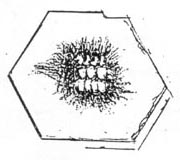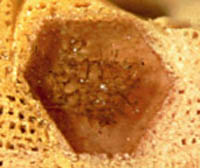"Wood crystals"
Part 1
This is not about quartz crystals in silicified wood, which
is a common
phenomenon, but about wood preserved within quartz crystals, which
apparently had never been noticed before. A monograph [1] listing all
inclusions seen in quartz crystals does not mention wood tissue. One
may wonder why but there is a possible explanation: The inlusions had
been found by mineral collectors mainly
interested in crystals of cm-size and above. If
they look at crystals
of mm-size and below, then for the arrangement of crystal faces but not
for the "dirt" enclosed. Also they probably never inspected
the tiny quartz crystals often seen in silicified wood. This may
explain why pictures like Fig.1 have been perceived as stunning, also
by R. Rykart,
the author of the Quartz Monograph [1].

Fig.1 (right): A small part of
coniferous wood preserved within a
quartz crystal. Width of the crystal 0.8mm.

Fig.2 (left): Silicified coniferous-type
wood cross section with quartz crystal
with traces of wood preserved within. Width of the crystal 0.6 mm.
The particular aspect of the specimens in Figs.1,2,
where the crystal axis coincides with the
wood axis, and with wood confined to the centre, is not typical
for the phenomenon. Apparently, wood inside crystals is more easily
discovered in such cases where the cut is perpendicular to the
tracheids, and if the cut is perpendicular
to the crystal axis, too, it is all the more
conspicuous.
Quartz crystal sections with less regular shape but with wood
throughout are seen in Fig.3. 
Fig.3
(right): Coniferous wood preserved within quartz
crystals in fossil wood. Width of the picture 2mm.
Judging
from the equal orientation of the wood in the quartz grains in Fig.3
one can conclude that the whole is not a heap of petrified
wood fragments but crystals grown
within the wood while the wood was still coherent. They must have grown
through the wood without hindrance as if the wood were not there, which
indicates that the wood substance had already been essentially
dissolved but the dark decay products were still arranged in their
original position, probably in silica gel, so that the overall wood
structure was still visible and became incorporated into the crystals
and safely preserved there.
Since quartz crystals are more resistant
to dissolution than chalcedony, it appears that the most suitable place
for the persistence of a fossil structure is inside a quartz crystal.
Apparently,
these pictures show the first fossils discovered inside crystals. It
seems worth while looking for fossils other than wood making use
of this safe means of preservation.
"Wood crystals" had been first published in 1999 [2]
although the phenomenon is widespread
and could well have been discovered in times when fossil wood was first
inspected with a microscope. Apparently the
palaeontologists did not expect the like and therefore did not closely
look at the crystals, possibly under
the influence of the scholastic
subdivision of Nature into mineral
kingdom, plant kingdom, and
animal kingdom, considered naive now, which made them ignore
the crystals since they did not
belong to their two kingdoms of interest. As an exception to such
attitude, H. Huhle
looked for and found Tertiary wood inside
quartz cystals [3].
The present samples had been found among gravel near the
Kyffhäuser Mountains,
Germany, uppermost Carboniferous [4],
and provided by W.+G.
Etzrodt,
Borxleben.
Sample labels: Fig.1: KyB/48.2, Fig.2: KyB/24.2,
Fig.3: KyB/38.1
H.-J. Weiss 2011, emended 2016
[1] R. Rykart:
Quarz-Monographie, Ott Verlag Thun, 1989
[2] H.-J.
Weiss, R. Noll: "Holzkristalle".
Veröff. Mus. Naturk. Chemnitz 22(1999), 57-64.
[3] H.
Huhle: Holz
im Quarz. Veröff. Mus. Naturk. Chemnitz 27(2004), 123-24.
[4]
J.
Schneider, R. Rößler,
B. Gaitsch: Stratigraphy
and facies of the Middle European continental Carboniferous and Permian
excursion guide A5, 1995.
|

|
 1 1 |

 1
1



 1
1